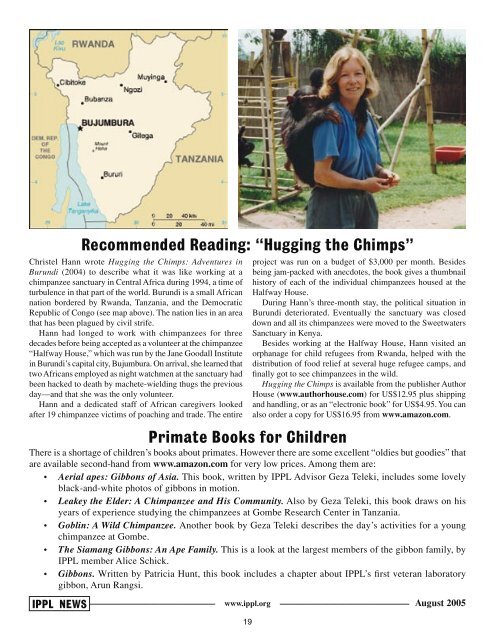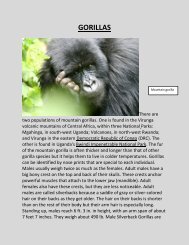IPPL News Aug05.indd - International Primate Protection League
IPPL News Aug05.indd - International Primate Protection League
IPPL News Aug05.indd - International Primate Protection League
You also want an ePaper? Increase the reach of your titles
YUMPU automatically turns print PDFs into web optimized ePapers that Google loves.
Recommended Reading: “Hugging the Chimps”<br />
Christel Hann wrote Hugging the Chimps: Adventures in<br />
Burundi (2004) to describe what it was like working at a<br />
chimpanzee sanctuary in Central Africa during 1994, a time of<br />
turbulence in that part of the world. Burundi is a small African<br />
nation bordered by Rwanda, Tanzania, and the Democratic<br />
Republic of Congo (see map above). The nation lies in an area<br />
that has been plagued by civil strife.<br />
Hann had longed to work with chimpanzees for three<br />
decades before being accepted as a volunteer at the chimpanzee<br />
“Halfway House,” which was run by the Jane Goodall Institute<br />
in Burundi’s capital city, Bujumbura. On arrival, she learned that<br />
two Africans employed as night watchmen at the sanctuary had<br />
been hacked to death by machete-wielding thugs the previous<br />
day—and that she was the only volunteer.<br />
Hann and a dedicated staff of African caregivers looked<br />
after 19 chimpanzee victims of poaching and trade. The entire<br />
——————————————————————— <strong>IPPL</strong> NEWS<br />
www.ippl.org ———————————————— August 2005<br />
19<br />
project was run on a budget of $3,000 per month. Besides<br />
being jam-packed with anecdotes, the book gives a thumbnail<br />
history of each of the individual chimpanzees housed at the<br />
Halfway House.<br />
During Hann’s three-month stay, the political situation in<br />
Burundi deteriorated. Eventually the sanctuary was closed<br />
down and all its chimpanzees were moved to the Sweetwaters<br />
Sanctuary in Kenya.<br />
Besides working at the Halfway House, Hann visited an<br />
orphanage for child refugees from Rwanda, helped with the<br />
distribution of food relief at several huge refugee camps, and<br />
finally got to see chimpanzees in the wild.<br />
Hugging the Chimps is available from the publisher Author<br />
House (www.authorhouse.com) for US$12.95 plus shipping<br />
and handling, or as an “electronic book” for US$4.95. You can<br />
also order a copy for US$16.95 from www.amazon.com.<br />
<strong>Primate</strong> Books for Children<br />
There is a shortage of children’s books about primates. However there are some excellent “oldies but goodies” that<br />
are available second-hand from www.amazon.com for very low prices. Among them are:<br />
• Aerial apes: Gibbons of Asia. This book, written by <strong>IPPL</strong> Advisor Geza Teleki, includes some lovely<br />
black-and-white photos of gibbons in motion.<br />
• Leakey the Elder: A Chimpanzee and His Community. Also by Geza Teleki, this book draws on his<br />
years of experience studying the chimpanzees at Gombe Research Center in Tanzania.<br />
• Goblin: A Wild Chimpanzee. Another book by Geza Teleki describes the day’s activities for a young<br />
chimpanzee at Gombe.<br />
• The Siamang Gibbons: An Ape Family. This is a look at the largest members of the gibbon family, by<br />
<strong>IPPL</strong> member Alice Schick.<br />
• Gibbons. Written by Patricia Hunt, this book includes a chapter about <strong>IPPL</strong>’s first veteran laboratory<br />
gibbon, Arun Rangsi.










